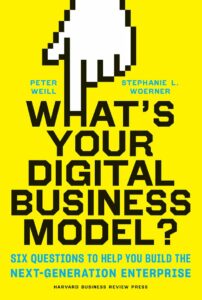Transform Your Business
Digital transformation. We read about it often. Organizational leaders struggle to determine the possible threats, the impending changes needed, the opportunities that are possible.
Peter Weill and Stephanie L. Woerner’s new book, What’s Your Digital Business Model?, provides a strategic framework for thinking about these issues. Peter is a Senior Research Scientist and Chair of the Center for Information Systems Research at the MIT Sloan School of Management. Stephanie is also Research Scientist at the same institution with a specialty focusing on how companies manage organizational change caused by digital disruption.
I had the opportunity to speak with them about their research and new book.
Rate Your Digital Readiness
How would you rate most organizations readiness for the era of digital disruption that we are in and are facing?
Most organizations we talk to and research know they have to change to stay relevant and have improved in some areas (perhaps they’ve worked on business process optimization or they’ve automated a lot of processes). However, as customer experience demands have increased, we find that many older, bigger companies have not made the improvements and changes needed to address those demands. Plus the leaders of the average large company (more than $7B in revenue) identified that 46% of their revenues are under threat over the next 5 years if they don’t change.
How was the research developed?
The book is based around six questions we think every executive and organization has to be able to answer in order to be competitive in the digital economy. We started this research by interviewing leaders from large, global companies, asking them to describe their most important digitally-enabled business transformation initiative. From there we developed a model, tested the preliminary findings in more than 50 workshops with senior executives, identified capabilities needed, conducted several surveys to test those capabilities and show links to financial performance, and interviewed many companies to help us understand what it takes to transform a business. The book resulted from five years of research which shows that the senior executives of top performing firms honestly answered the six questions. To help, each chapter concludes with a self-assessment on one of the six questions. The reader can then compare their self-assessment results to top financial performers to help leadership teams understand the gap they have to close.
Needed: Honest Conversations about the Future
Of the six parts, is there one step that more organizations get stuck in than another?
 Probably the hardest question for most organizations is having an honest conversation about whether they have leadership, at all levels, who will persevere and successfully deliver the business transformation. Along the way the culture will have to change and adapt to the new digital business model and often this means changing people at the top. But it is not just the top layer of leaders that has to change. Successful transformation requires getting the whole company to behave differently – from the board to the lowest level of employees. For example, DBS Bank in Singapore, which was one the Euromoney’s most digital banks in 2016 has managed to get 14,800 of their 22,000 people involved in a digital innovation activity every week.
Probably the hardest question for most organizations is having an honest conversation about whether they have leadership, at all levels, who will persevere and successfully deliver the business transformation. Along the way the culture will have to change and adapt to the new digital business model and often this means changing people at the top. But it is not just the top layer of leaders that has to change. Successful transformation requires getting the whole company to behave differently – from the board to the lowest level of employees. For example, DBS Bank in Singapore, which was one the Euromoney’s most digital banks in 2016 has managed to get 14,800 of their 22,000 people involved in a digital innovation activity every week.
How likely is it that an organization needs outside, independent help to investigate these questions? Put another way, if you do this on your own, how likely are you to be accurate?
Many organizations use independent outsiders to help them investigate the questions in the book. One of the best ways to use outside independent help is to facilitate workshops with senior leadership and the board about strategy and direction. Companies get an unvarnished opinion and the workshop is a great opportunity to get all of the leadership aligned and on the same page. It’s been surprising to us when we’ve done workshops to see the diversity of opinions around the six questions and gratifying to watch a senior team start to come to agreement about the future.
Amplify the Customer’s Voice
You share eight organizational capabilities. Let’s touch on one: “Amplifying the customer voice inside the enterprise.” How is the customer-centric view changing in light of the digital age?
Customer behavior is pushing companies to be increasingly customer centric. Customers are judging the experience they have with any company against the best experiences – like those at Apple, Amazon and Google– they see across all industries. The new technologies like social, mobile, analytics, cloud, AI, and internet of things have the potential to come together and offer companies big opportunities to reinvent both their customer experience and their efficiencies. However, just deploying these technologies isn’t enough—companies need to use these technologies to listen to customers and craft compelling products and solutions for their customers. We see many companies using measures like Net Promoter Score to measure how well they are listening to and addressing customer issues. And those measures are disseminated throughout the company to amplify the customer voice. If you add social sentiment analysis, customer behavior data analytics and test and learn approaches to the mix, top-performing companies really amplify the customer voice.
Your final chapter covers the role of leaders in creating the next-generation enterprise. Would you briefly share some of the roles that are important at all levels?

The CEO is key in creating the next-generation enterprise. The CEO must commit to the transformation and monitor its progress, motivate a culture change, and communicate the vision. The CEO also chooses the executive committee, which helps reinforce and carry out the vision. The CEO is also responsible for doing any organizational surgery, like reorganizing the company, a difficult process from which there will be winners and losers. An involved board will allocate the capital for transformation, back up the CEO on the difficult decisions, and provide counsel. The CIO and the IT unit bring many skills to a digital business transformation including experience integrating siloes into platforms, familiarity with technologies, service enabling core business processes, and digital innovation. Finally, don’t underestimate the role of the workforce. The workforce is the front line of the organization and who most of the customers interact with. They often have an enthusiasm for change and expertise with the technologies that customers use to interact with the company.
Due to the nature of this disruption, what challenges are today’s leaders facing that are unique from predecessors?

In some ways, a transformation to a new digital business model is an organizational change, like previous organizational changes. However, there are some unique differences. Digital technologies allow companies to build deep engagement with their customers and create the opportunity to maintain strong relationships across the globe. Company boundaries are more porous, and it has become easier to develop new types of partnerships and ways of working. Companies are experimenting with ecosystem relationships.
For more information, see What’s Your Digital Business Model?.

